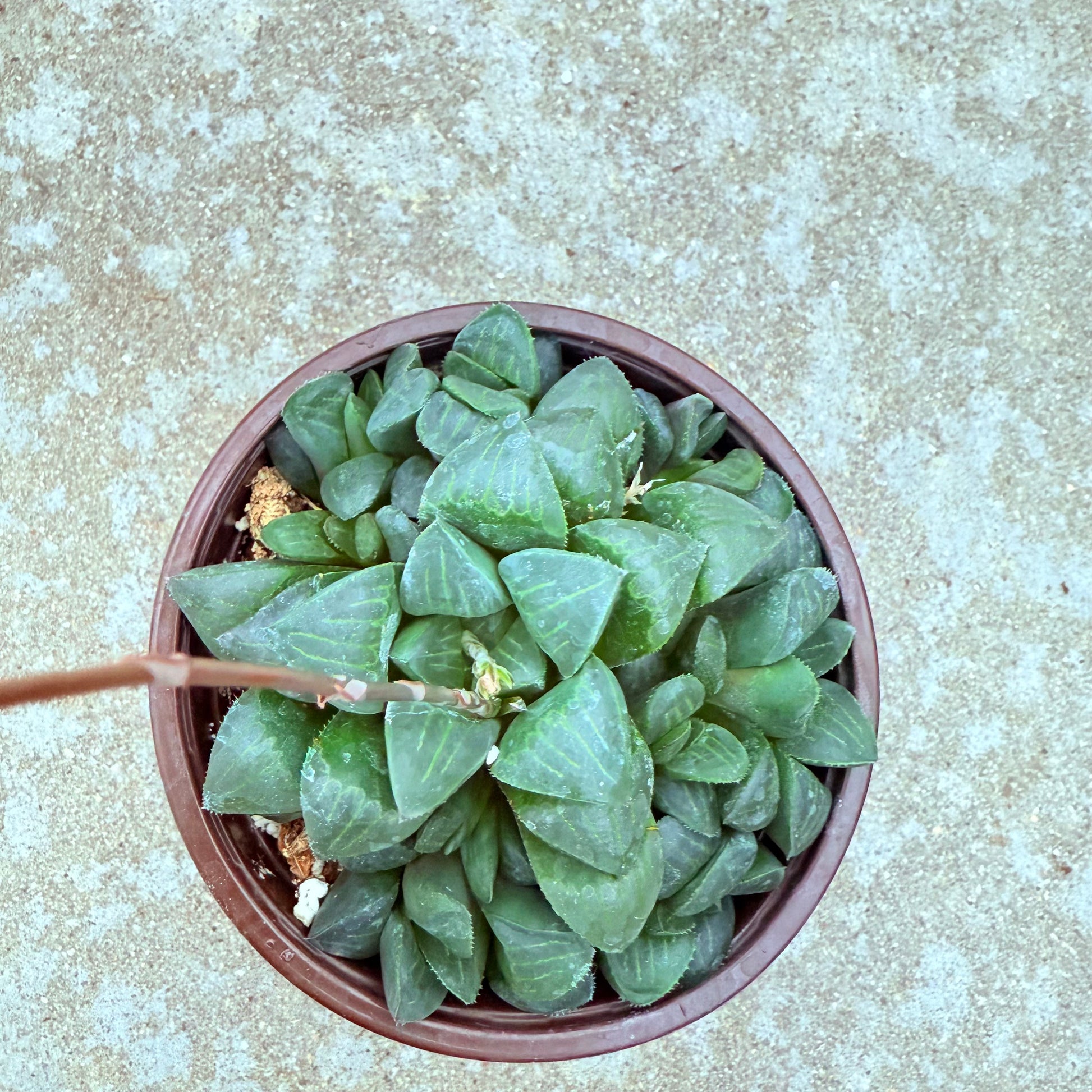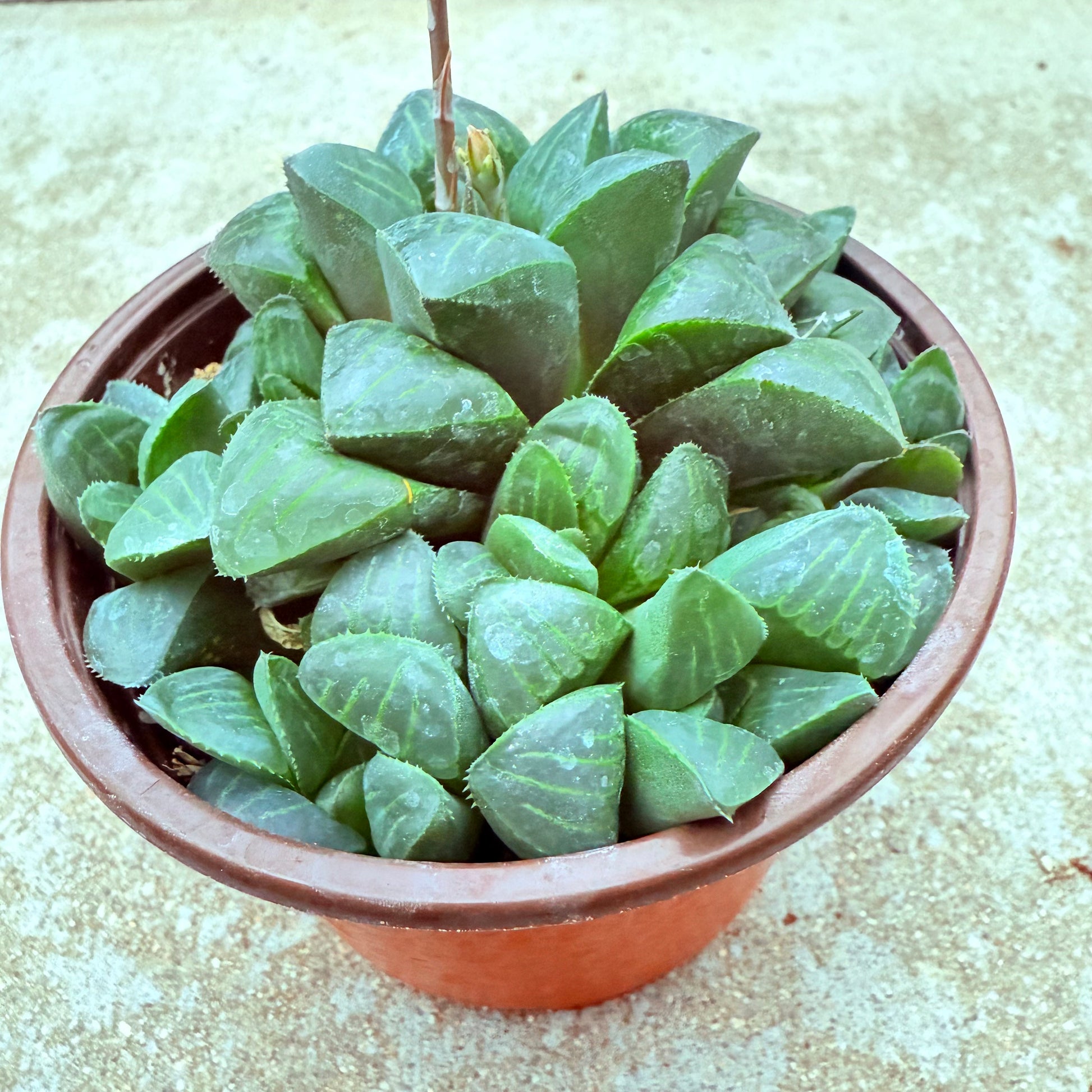Haworthia mutica
Haworthia mutica
In stock
Couldn't load pickup availability
📝 Description
**Morphological Characteristics**
Haworthia mutica is a compact, slow-growing succulent species in the Asphodelaceae family, native to the Western Cape region of South Africa. It is especially prized for its striking leaf patterning and smooth, architectural rosette form.
The plant forms a tight, low rosette of thick, fleshy, triangular leaves. Leaves are generally light to dark green and often display pale, translucent "windows" or fine lines across the upper surface. These markings vary widely between individuals, making each plant unique. The rosettes typically reach about 5-10 cm (2-4 inches) in diameter and 3-5 cm (1-2 inches) in height. In summer, Haworthia mutica may produce a slender, wiry flower stalk (inflorescence) bearing small, tubular, white flowers with greenish or brownish veins.
**Growth Habits**
Haworthia mutica is a very slow-growing succulent that remains small and manageable throughout its life. It is generally solitary but may eventually produce a few offsets around the base. Its modest size and tolerance for partial shade make it an excellent choice for windowsill gardens, terrariums, or small succulent arrangements.
**Maintenance Points**
• Lighting: Prefers bright, indirect light to partial shade. Too much direct sun can cause leaf scorching, while too little light may result in elongated, weak growth.
• Watering: Water thoroughly when the soil is completely dry. During the growing season (spring and fall), maintain a moderate watering schedule. In winter, reduce watering to a minimum.
• Soil: Requires a very well-draining succulent mix. Incorporate coarse sand, pumice, or perlite to enhance aeration and mimic native sandy soils.
• Temperature: Ideal temperatures are between 18-27°C (65-80°F). Protect from frost; temperatures below 5°C (41°F) can damage the plant.
• Fertilization: Apply a diluted, balanced succulent fertilizer once or twice during the growing season. Avoid overfertilization, which can cause soft, unnatural growth.
• Potting: Use shallow pots with good drainage. Repotting is rarely needed, typically only every 3-4 years or when offsets are removed.
• Humidity: Prefers low humidity and good airflow to prevent fungal issues.
**Reproduction Method**
Haworthia mutica can be propagated by offsets and seeds.
1. **Offsets:**
• Selection: Carefully separate small offsets from the parent rosette using a clean, sharp tool.
• Callusing: Allow the offsets to dry and callus over a day or two before planting.
• Planting: Insert into a well-draining succulent mix. Water lightly after a few days.
2. **Seeds:**
• Sowing: Sow seeds on the surface of a fine, well-draining seed mix.
• Germination: Maintain slight moisture and a temperature range of 20-25°C (68-77°F). Germination may take several weeks.
• Transplanting: Once seedlings are sturdy enough, transplant them into individual pots.
**Additional Tips**
• Pests: Monitor for mealybugs, aphids, and fungal gnats. Treat infestations promptly with insecticidal soap or neem oil.
• Disease Prevention: Avoid overwatering and ensure excellent drainage to prevent root rot.
• Growth Cycle: Haworthia mutica tends to grow actively during the cooler months of spring and fall, entering a semi-dormant state during summer heat.
• Display: Its compact size and ornamental leaf patterns make it perfect for tabletop displays, mixed succulent gardens, or specialty collections.
With its elegant structure, subtle beauty, and forgiving care requirements, Haworthia mutica is a must-have succulent for both beginner and experienced plant enthusiasts.
🌿 Care Tips
Plant Care
Light
Water
Soil
Temperature
Hardiness
Fertilizer
Propagation: Leaf/offset cuttings
Common issues: Etiolation, mealybugs, rot
🌟 Note: It’s normal for succulents to appear slightly shriveled after shipping. They usually recover within a few days in a suitable environment.
📦 Shipping Info
Seah Shipping Policy
Effective Date: November 2025
This Shipping Policy applies to orders delivered within the continental United States (the lower 48 states). By purchasing from Seah, you agree to the terms below.
1) Shipping Cost & Free Shipping
- Automatic rate calculation: Shipping is calculated at checkout based on weight, destination ZIP and carrier rates.
- Free Standard Shipping: Orders $59+ (pre-tax, after discounts) ship free to the lower 48 states.
- Alaska, Hawaii, Puerto Rico & other territories: Not eligible for free shipping or standard flat offers at this time.
- Taxes/Duties: Applicable sales tax and any fees are shown at checkout.
2) Processing Schedule
- Business days only: We process and ship Monday–Friday. No shipping on weekends or U.S. federal holidays.
- Handling time: 1–3 business days after payment confirmation.
- Cut-off time: Orders placed before 3:00 PM (PST) are prioritized for same-day processing; others roll to the next business day.
- Changes/Cancellations: Email support@seah.co within 12 hours of purchase; after that, the order may already be in processing.
3) Transit Times
| Method | Estimated Transit | Total ETA (Handling + Transit) |
|---|---|---|
| Standard | 5–8 business days | 6–11 business days |
| Express | 3–4 business days | 4–7 business days |
ETAs are estimates. Weather, holidays, carrier delays or high-volume periods may extend delivery times.
4) Seasonal Temperature & Plant Safety
- Winter (Nov–Mar): We strongly recommend adding a heat pack at checkout to protect plants from freezing. Orders shipped without a heat pack during cold conditions are not covered for cold damage.
- Summer heat: During extreme heat waves, we may hold shipments until temperatures normalize. We’ll notify you if there’s a hold.
- Packaging: Plants are carefully packed (bare-root or potted by type/size) to minimize transit stress.
5) Carriers & Tracking
- We ship via USPS / UPS / FedEx, selected automatically for best service to your address.
- When your order ships, you’ll receive a tracking email. Tracking typically activates within 24 hours.
- If you haven’t received tracking within 3 business days, contact us at support@seah.co or +1 (626)-999-1314.
6) Address Changes & Delivery Issues
- Before shipment: Request address changes within 12 hours of ordering.
- After shipment: We can’t modify the address once dispatched. Please contact the carrier for redirection options.
- PO Boxes: Supported for USPS only; UPS/FedEx require a street address.
- Seah isn’t responsible for delays or loss due to incorrect addresses provided at checkout.
7) Service Area
We currently ship to the continental U.S. (lower 48 states). Orders to AK/HI/PR and other territories are not eligible for free shipping and may be restricted.
8) Support
- Hours: Mon–Fri, 9:00 AM – 5:00 PM (PST)
- Phone: +1 (626)-999-1314
- Email: support@seah.co
- Address: 7870 Margaux Pl, Rancho Cucamonga, CA 91739, United States
Thank you for supporting our California nursery—each plant is hand-selected and packed with care. 🌱




